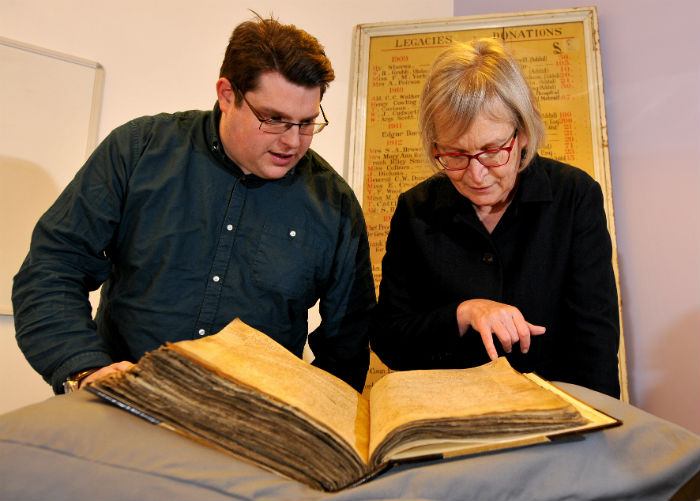Researchers unravel secrets of medieval life up North
Posted on Monday 4 February 2019

Gary Brannan, Archivist, and Professor Sarah Rees Jones examine one of the registers
Joan of Leeds was fed up of her life in a medieval nunnery. By 1318, her urge to escape the vows she had pledged to poverty, chastity and obedience had grown so strong that she resorted to faking her own death.
After tricking her fellow sisters into burying a dummy they believed to be her body, Joan fled. But alas, her freedom was short lived as she was soon discovered and ordered to return to the convent by the Archbishop of York.
Archivists from the Borthwick Institute for Archives at the University of York have uncovered Joan’s story as they begin to explore registers recording the business of the archbishops of York between 1304 and 1405.
Secrets
Ink, skilfully scrawled onto parchment by medieval scribes, preserves the secrets of people – from nobles to peasants and bishops to curates - who lived during periods of disease, war, famine, political strife and religious reformation in the King’s City in the North and surrounding province.
Before coming into the University’s care, the 16 heavy volumes had endured a perilous existence and have not been extensively studied. In the Middle Ages they were carried by the Archbishop’s officials on his travels; after the English Civil War they found their way to storage in London, only being restored to the Diocesan Registry in York Minster in the late eighteenth century. Parts of some registers have been published, but often untranslated from the original Latin.
Now, with an injection of just under £1m of funding from the Arts and Humanities Research Council, a research team of medieval historians and archivists from the University and The National Archives (UK) are taking on the painstaking task of translating the volumes and indexing them to make their contents digitally available to all for free.
Rich account
“Archbishops of York in the fourteenth century had incredibly varied roles,” explains Professor Sarah Rees Jones, medieval historian at the University of York and Principal Investigator on the project.
“On the one hand they carried out diplomatic work in Europe and Rome and rubbed shoulders with the VIPs of the Middle Ages. However, they were also on the ground resolving disputes between ordinary people, inspecting priories and monasteries and correcting wayward monks and nuns.
“That’s why these Registers provide such a rich account of people from all walks of fourteenth-century life during a fascinating and extremely turbulent period.”
Priest army
Over the course of their research, the team is hoping to find out more about some of history’s most extraordinary archbishops - characters such as William Melton, who led an army of priests and citizens into battle to defend the City of York against the Scots in 1319.
“In the Middles Ages, York was an extremely important northern city on the frontline of the Scottish wars of independence,” says Professor Rees Jones. “But unfortunately the fight didn’t go well for Melton and his army of clergy. Their lack of military training resulted in a reported 4,000 men dying on the battlefield and a further 1,000 are believed to have drowned in the River Swale trying to escape.”
Not all archbishops of York documented by the registers were such loyal subjects to their kings. Archbishop Richard le Scrope was executed in 1405 for his participation in the Northern Rising against Henry IV - an act immortalised in the eponymous Shakespeare play. “The records may well provide more information on this episode and offer some fresh insights into Scrope’s motivations for getting involved,” Professor Rees Jones adds.
Black Death
The registers also chronicle the Black Death which swept through Europe from 1347 to 1351 and wiped out 60% of the British population. “The equivalent would be if 40 million people died in Britain today within the space of around four years” says Professor Rees Jones. “There were empty monasteries and entire villages were decimated.”
“Being a priest was one of the most dangerous jobs in Europe during that time as they visited the sick and administered last rites at death beds.”
New light
However, the Black Death did bring about important change in the church. “Because so many priests had died there weren’t enough people trained in Latin, so delivering sermons in English had to be adopted as the new status quo,” Professor Rees Jones adds.
“The registers may shed new light on what it was like to live through this period and will perhaps give us a sense of how the Church reasserted its authority after such catastrophic events.”
The project, called ‘The Northern Way’ will run for 33 months in partnership with The National Archives (UK) and with the support of the Chapter of York Minster. The team will also generate a programme of lectures, publications and joint research with local history groups and postgraduate students.
Northern identity
Once indexed, the material from the registers will be linked via the York’s Archishops’ Registers Revealed platform to ecclesiastical records at The National Archives, the British Library and York Minster to provide a complete picture of the role of the northern archbishops in national affairs.
“These chronicles will give us a window into the lives of important figures and ordinary people,” Professor Rees Jones says. “Their revelations may change our perception of northern identity and parts of history as we know it.”
